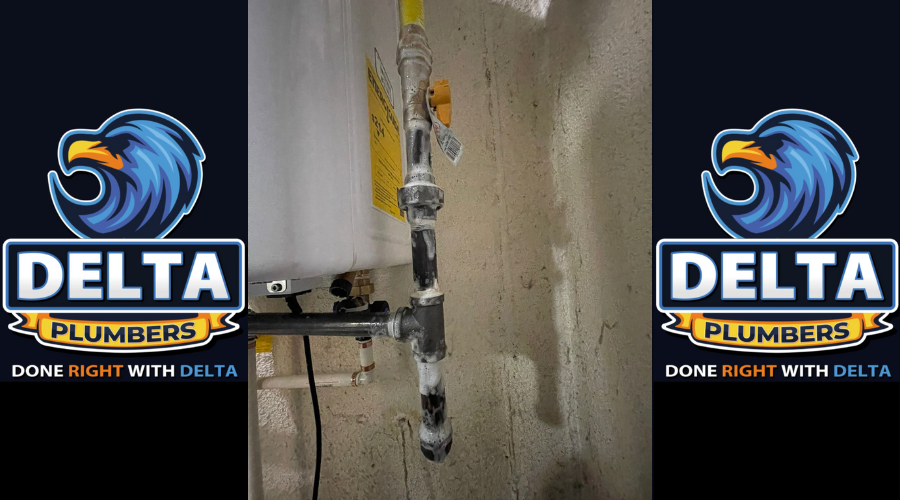Frozen pipes can cause serious damage to your plumbing system if not handled properly. At Delta Plumbers, we understand the risks associated with frozen pipes and want to help you avoid any major issues. This comprehensive guide will provide you with expert advice on how to safely thaw frozen pipes and prevent them from bursting, including what to do if you can’t access the pipe, whether you should turn on your faucet, and the role of hot water. Let’s dive into the details to keep your home safe during freezing weather.

Picture Source – Delta Plumbers
How Do You Thaw Frozen Pipes Without Bursting?
When dealing with frozen pipes, the number one concern is avoiding a pipe burst. As water freezes inside your pipes, it expands, causing pressure to build up. If this pressure gets too high, the pipe can rupture. Here are some methods you can use to safely thaw frozen pipes without causing a burst:
1. Turn Off the Water Supply
Before you start the thawing process, make sure to turn off the main water supply. This step reduces the pressure in the system and minimizes the risk of a burst pipe.
2. Open Faucets
It’s essential to open the faucet connected to the frozen pipe. Opening the faucet allows the melted water to flow out, which relieves pressure and prevents the build-up of excessive force inside the pipe. Start by opening both the hot and cold taps if it’s a mixed system, ensuring water has an outlet once it starts to thaw.
3. Use Safe Heating Methods
You need to apply heat to the section of the pipe that’s frozen to thaw it gradually. Here are some safe heating options:
- Hairdryer: Move the hairdryer back and forth along the frozen pipe. Avoid concentrating heat in one spot for too long, as this could cause cracking.
- Hot Towels: Wrap hot towels around the pipe. Replace them frequently to maintain warmth.
- Space Heater: Position a space heater close to the frozen pipe (but not touching) to warm up the surrounding air.
- Heat Tape: Electric heat tape is another option. Wrap the tape around the pipe and plug it in to generate gentle heat.
4. Avoid Open Flames
Never use a blowtorch, propane heater, or any other open flame to thaw frozen pipes. These methods are dangerous and can lead to severe damage to your plumbing, not to mention the fire hazard they present.
By following these methods, you can thaw frozen pipes safely and minimize the chances of them bursting.
Also Read: How to Repair a Leaking Shower: A Complete Guide by Delta Plumbers

Picture Source – Delta Plumbers
How Long Does It Take for Frozen Pipes to Thaw?
The time it takes to thaw frozen pipes can vary depending on several factors such as the size of the pipe, the temperature in the environment, and the method you’re using to thaw the pipe. Typically, it takes anywhere from 30 minutes to a couple of hours to thaw frozen pipes safely.
Factors That Affect Thawing Time:
- Pipe Size and Material Larger pipes take longer to thaw than smaller ones. Additionally, metal pipes (especially copper) conduct heat better than plastic pipes, so they may thaw faster.
- Extent of Freezing If only a small portion of the pipe is frozen, it will thaw more quickly. However, if the freezing has spread to a large section of the pipe, expect the process to take longer.
- Heating Method The type of heat source you use will affect the thawing time. For example, using a hairdryer will likely take longer than using a space heater or heat tape.
- Room Temperature If the room or area where the pipe is located is warmer, the thawing process will naturally speed up. If possible, increase the ambient temperature in the area to help the process along.
In most cases, patience is key when thawing frozen pipes. Rushing the process by using extreme heat sources can cause the pipe to burst, which is much more problematic.
Also Read: Prevent Clogs in Your Kitchen Sink: How to Do It Guide by Delta Plumbers

Picture Source – Delta Plumbers
Will Frozen Pipes Thaw on Their Own?
Yes, frozen pipes may eventually thaw on their own if the surrounding temperature rises above freezing. However, relying on nature to solve the problem can be risky. As the ice inside the pipe melts, it can cause sudden changes in pressure, increasing the likelihood of a burst.
Why You Shouldn’t Wait for Pipes to Thaw Naturally:
- Risk of Bursting Frozen pipes that thaw naturally are at higher risk of bursting. This is because the gradual melting process can create localized pressure points, leading to cracks or ruptures.
- Potential Water Damage If the pipe bursts while you’re waiting for it to thaw on its own, you could be dealing with major water damage to your home. By taking proactive measures, you can avoid costly repairs.
- Extended Water Supply Interruption If you leave frozen pipes unattended, you may be without running water for an extended period, which can be a significant inconvenience, especially in colder months.
Rather than waiting for the pipes to thaw on their own, it’s best to follow the thawing methods mentioned earlier to ensure a safe and controlled process.
Also Read: Professional Drain Cleaning Service: Benefits and More

Picture Source – Delta Plumbers
How Do You Thaw Frozen Pipes If You Cannot Access It?
In some cases, the frozen section of the pipe may be hidden behind walls, under floors, or in other hard-to-reach areas. Thawing these pipes can be challenging, but there are methods to address the issue.
1. Increase Ambient Heat
If the pipe is located behind a wall or under the floor, try to increase the temperature in the room where the frozen pipe is located. You can use a space heater, heating blanket, or raise the thermostat to distribute warmth to the entire area.
2. Infrared Heater
Infrared heaters are effective for thawing pipes located behind walls. The heat penetrates through the surface, warming the pipe without damaging the surrounding materials.
3. Cut Open the Wall or Floor
If the above methods don’t work, you may need to make a small cut in the wall or floor to access the pipe. While this is more labor-intensive, it ensures you can apply direct heat to the frozen section and prevent a burst.
4. Call a Professional
If the frozen pipe remains inaccessible and you’re unable to thaw it on your own, it’s time to call a licensed plumber. Professionals have specialized tools and equipment designed for these situations, including pipe thawing machines, which can thaw pipes quickly and safely.
At Delta Plumbers, we are equipped to handle these situations and can provide efficient, professional service to get your water flowing again.
Also Read: Repair a Leaking Water Heater: How to Do it?

Picture Source – Delta Plumbers
Should I Turn My Faucet on If My Pipes Are Frozen?
Yes, you should definitely turn on the faucet connected to the frozen pipe. Opening the faucet helps relieve pressure in the pipe and provides an outlet for the water as it thaws. This step can reduce the risk of a burst pipe.
How to Do It:
- Turn On Both Hot and Cold Taps If the frozen pipe is connected to a mixed system (both hot and cold water), open both taps to allow for more flexibility in pressure relief.
- Start with a Trickle Turn the faucet on slightly, allowing just a small trickle of water to come through. This helps to reduce pressure while the frozen water begins to melt.
- Monitor the Flow As the ice begins to thaw, you may notice the flow of water increasing. Keep the faucet open until the pipe has completely thawed and water is flowing freely.
By keeping the faucet open, you prevent the pressure from building up inside the pipe, reducing the risk of a burst.
Also Read: Benefits of Installing a Water Softener

Picture Source – Delta Plumbers
What to Do If Your Pipes Freeze Overnight?
Waking up to frozen pipes can be frustrating, but there are steps you can take to address the situation quickly and minimize damage.
1. Check All Faucets
Start by checking all faucets in your home to determine which pipes are frozen. If only one faucet has low or no water flow, then the problem is likely isolated to that section.
2. Turn On Affected Faucets
As mentioned earlier, open the faucets connected to the frozen pipes to allow pressure relief and an outlet for the thawing water.
3. Apply Heat
Once you’ve located the frozen pipe, start applying heat using the safe methods we outlined earlier (hairdryer, space heater, hot towels, etc.). Focus on the frozen section of the pipe and work your way toward the faucet.
4. Check for Leaks
As the pipe begins to thaw, inspect it for any signs of cracks or leaks. If you spot a leak, shut off the main water supply immediately and contact a plumber for repairs.
5. Avoid Using Open Flames
While it may be tempting to speed up the process by using a blowtorch or other open flames, this is extremely dangerous and should never be done. Stick to safe heating methods to prevent further damage.
By following these steps, you can thaw frozen pipes that freeze overnight and reduce the chances of a costly pipe burst.
Also Read: How to Install New Kitchen Faucet: Delta Plumbers

Picture Source – Delta Plumbers
Will Pouring Hot Water Down the Drain Unfreeze Pipes?
While pouring hot water down a drain may seem like a simple solution, it’s not always effective for unfreezing pipes, especially if the frozen section is deep within the plumbing system. Additionally, hot water can cause thermal shock to the pipes, leading to cracks or bursts.
Why It’s Not Recommended:
- Limited Access The hot water may not reach the frozen section of the pipe, particularly if the freezing has occurred farther along the line.
- Thermal Shock Pouring boiling water directly onto a frozen pipe can cause the pipe to expand too quickly, increasing the risk of a burst.
- Drain Pipes Are Different Frozen drain pipes are harder to thaw than water supply lines because they don’t carry pressurized water. In these cases, using hot water alone is often ineffective.
Better Alternatives:
- Use Safe Heating Methods: Apply heat directly to the frozen section of the pipe using a hairdryer, space heater, or hot towels.
- Increase Ambient Temperature: Raise the temperature in the room where the frozen drain pipe is located to help thaw it naturally.
If you suspect a frozen drain pipe and pouring hot water down the drain doesn’t resolve the issue, it’s best to contact a professional plumber to assess the situation.
Conclusion
Frozen pipes can lead to significant problems if not handled properly, but with the right approach, you can safely thaw your pipes without causing damage. At Delta Plumbers, we recommend turning off your water supply, opening faucets, and applying safe heat sources to thaw pipes gradually. Always avoid using open flames and ensure you take proactive steps to prevent pipes from freezing in the first place.
Remember, if you ever find yourself unable to thaw a frozen pipe or if the situation seems too risky, don’t hesitate to contact a professional plumber. We’re here to help with any emergency plumbing issues and ensure your home stays safe during the cold winter months.
By following this guide, you’ll be prepared to handle frozen pipes effectively, minimizing the risk of costly damage and ensuring your plumbing system runs smoothly.









